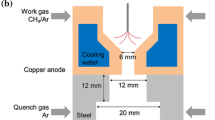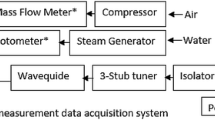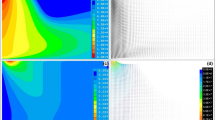Abstract
In this paper, we present a plasma rapid heater (PRH) designed to uniformly heat methane with electric arc thermal plasma and reduce loss rate. Our model uses a simplified and detailed mechanism to analyze the rapid and intense mixing process between a plasma mainstream and circumferential cold jets of methane in a hydrogen environment. The research focuses on three areas: the plasma mainstream section, the circumferential jet mixing chamber, and the reaction chamber. We investigate the characteristics of the mainstream and explore the impact of the jet momentum ratio on the mixing process and the losses from methane heating. We explain these phenomena using Damkohler numbers to demonstrate the relationship from a time-scale perspective. The findings indicate that an increased momentum ratio improves mixing, reduces temperature and material non-uniformity, and minimizes losses from pyrolysis during methane heating. Additionally, we provide a formula for calculating the penetration depth of the jet. The examination of Damkohler numbers also suggests that the momentum ratio primarily reduces methane losses by extending the reaction time scale. This work offers guidance on extending the usage of plasma heaters and integrating them into other industry processes in the future.














Similar content being viewed by others
Data Availability
The datasets used or analysed during the current study are available from the corresponding author on reasonable request.
References
Makogon YF, Holditch SA, Makogon TY (2007) J Petrol Sci Eng 56:14
Wang Q, Chen X, Jha AN, Rogers H (2014) Renew Sustain Energy Rev 30:1–28
Weiland P (2010) Appl Microbiol Biotechnol 85:849
Oni SI, Oyewo MA (2011) J Human Ecol 33(1):21
Horn R, Schloegl R (2015) Methane activation by heterogeneous catalysis. Catal Lett 145(1):23–39
Wang B, Albarracín-Suazo S, Pagán-Torres Y, Nikolla E (2017) Advances in methane conversion processes. Catal Today 285:147–158
Chein RY, Hsu WH, Yu CT (2017) Parametric study of catalytic dry reforming of methane for syngas production at elevated pressures. Int J Hydr Energy 42(21):14485–14500
An H, Cheng Y, Li TY, Li Y, Cheng Y (2018) Numerical analysis of methane pyrolysis in thermal plasma for selective synthesis of acetylene. Fuel Process Technol 172:195–199
Liu R, Hao Y, Wang T, Wang L, Bogaerts A, Guo H, Yi Y (2023) Hybrid plasma-thermal system for methane conversion to ethylene and hydrogen. Chem Eng J 463:142442
Holmen A, Olsvik O, Rokstad OA (1995) Pyrolysis of natural gas: chemistry and process concepts. Fuel Process Technol 42(2):249–267
Zhang HB, Cao TF, Cheng Y (2015) Preparation of few-layer graphene nanosheets by radio-frequency induction thermal plasma. Carbon 86:38–45
Xiaohang T (2017) Magnetic rotating arc plasma temperature diagnosis and its application to methane reforming reaction[D]. Zhejiang University, Zhejiang
Zhukov MF et al (2016) Arc plasma torch. Science Press, Beijing
Vadikkeettil Y, Amarnath P, Yugeswaran S, Ananthapadmanabhan PV (2022) Comparative study of plasma torch characteristics using air and carbon dioxide. IEEE Trans Plasma Sci 50(6):1395–1400. https://doi.org/10.1109/TPS.2021.3129593
Shicong B, Wenkang G, Minyou Y, Ping X, Xiaodong Z (2008) Characteristics and thermal efficiency of a non-transferred dc plasma spraying torch under low pressure. Plasma Sci Technol 10(6):701
Yan C, Tianyang Li, Yong J, Yi C (2016) Development and application progress of chemical conversion processes in super high temperature plasma. Chem Ind Eng Progr 35(6):1676–1686 ((in Chinese))
Young RM, Pfender E (1989) A novel approach for introducing particulate matter into thermal plasmas: the triple-cathode arc. Plasma Chem Plasma Process 9(4):465–481
PFENDER EMIL [US]. Multiple arc plasma device with continuous gas jet. Chinese Patent: US4818837 A, 1989.04.04
Schein J, Zierhut J, Dzulko M, Forster G, Landes KD (2007) Improved plasma spray torch stability through multi-electrode design. Contrib Plasma Phys 47(7):498–504
Oberste Berghaus J, Marple B, Moreau C (2006) Suspension plasma spraying of nanostructured WC-12Co coatings. In: 2006 international thermal spray conference (ITSC 2006)
Zhang Z, Wang C, Sun Q, Xia W (2021) Three-dimensional non-equilibrium modeling of a DC multi-cathode arc plasma torch. Plasma Sci Technol 23(7):075404
Xu X, Ren Z, Yang S (2021) Design and optimization of a hybrid excitation system for magnetically driven rotating DC arc plasma generators. IEEE Access 9:157012–157020
Gangoli SP, Gutsol AF, Fridman AA (2010) A non-equilibrium plasma source: magnetically stabilized gliding arc discharge: II. Electrical characterization. Plasma Sources Sci Technol 19(6):065003
Wang C, Cui H, Zhang Z, Xia W, Xia W (2017) Observation of arc modes in a magnetically rotating arc plasma generator. Contrib Plasma Phys 57(9):395–403
Ma J, Zhang M, Wu JH, Yang QW, Wen GD, Su BG, Ren QL (2017) Hydropyrolysis of n-hexane and toluene to acetylene in rotating-arc plasma. Energies 10(7):899
Li L (2008) Experimental study and numerical simulation of magnetically dispersed arc plasma. Univers Sci Technol China. https://doi.org/10.7666/d.y1270494. ((in Chinese))
Perambadur J, Klimenko AY, Rudolph V, Shukla P (2022) Investigation of plasma swirl dynamics and effects of secondary gas injection in a vortex gas stabilized DC arc plasma. Int J Heat Fluid Flow 95:0142-727X
Wu GQ, Li HP, Bao CY, Chen X, Li H-P (2009) Modeling of the heat transfer and flow features of the thermal plasma reactor with counter-flow gas injection. Int J Heat Mass Transfer 52:760–766
Zhang X, Liu Z, Tanaka M, Watanabe T (2021) Formation mechanism of amorphous silicon nanoparticles with additional counter-flow quenching gas by induction thermal plasma. Chem Eng Sci 230:116217
Zhou X et al (2023) Quasi-direct numerical simulations of the flow characteristics of a thermal plasma reactor with counter flow jet. Plasma Sci Technol. https://doi.org/10.1088/2058-6272/acb9d8
Smith GP, Golden DM, Frenklach M, Moriarty NW, Eiteneer B, Goldenberg M, Thomas Bowman C, Hanson RK, Song S, Gardiner WC, Jr., Lissianski VV, Qin Z http://combustion.berkeley.edu/gri-mech/
Yang WJ et al (2014) Experimental and numerical investigations of hydrogen–air premixed combustion in a converging–diverging micro tube. Int J Hydrogen Energy 39(7):3469–3476
Carlos Fernandez-Pello A (2002) Micropower generation using combustion: Issues and approaches. Proc Combust Inst 29(1):883–899
Chen T, Che H-Q (2019) Steady-state simulation of different discharge modes of argon arc under external magnetic field. Plasma Sources Sci Technol 28(12):125001
Pan Z, Ye L, Qian S, Sun Q, Wang C, Ye T, Xia W (2020) Comparison of Reynolds average Navier-Stokes turbulence models in numerical simulations of the DC arc plasma torch. Plasma Sci Technol 22(2):62–74
Menter FR, Esch T (2001) Elements of industrial heat transfer predictions. In: Proc. 16th Brazilian congress of mechanical engineering (Uberlandia, Brazil)
Gleizes A, Gonzalez JJ, Freton P (2005) Thermal plasma modelling. J Phys D Appl Phys 38(9):R153–R183
Zhou Q (2009) Numerical simulation of DC arc plasma torch. Fudan University, Shanghai. https://doi.org/10.7666/d.y1970249 ((in chinese))
Zhou QH, Yin HT, Li H, Xu X, Liu F, Guo SF, Chang XJ, Guo WK, Xu P (2009) The effect of plasma-gas swirl flow on a highly constricted plasma cutting arc. J Phys D-Appl Phys 42(9):095208
Pan Z, Chen X, Yuan X et al (2021) The effects of graphite particles on arc plasma characteristics. Plasma Chem Plasma Process 41(4):1183–1203
Zhu C, Chen X-H, Wang C, Song M, Xia W-D (2023) Calculation of thermodynamic properties and transport coefficients of Ar-C-Si plasma. Acta Phys. Sin. 72(12):1252021–12520212. https://doi.org/10.7498/aps.72.20222390
Chase MW, Davies CA, Downey JR, Frurip DJ, McDonald RA, Syverud AN https://janaf.nist.gov/
Acknowledgements
This work is supported by National Natural Science Foundation of China (No. 120350015) and Youth Fund of the National Natural Science Foundation of China (No. 12105282).
Funding
Youth Fund of the National Natural Science Foundation of China (No. 12105282) and National Natural Science Foundation of China (No. 12035015).
Author information
Authors and Affiliations
Contributions
SW: Conceptualization, Methodology, Software, Investigation, Formal analysis, Writing—original draft, Writing—review & editing. DK: Partial data processing. XC: Conceptualization, Funding acquisition, Resources, Supervision, Writing -review & editing. CW: Resources, Supervision. WX: Resources, Supervision, Data curation, Project administration. All authors reviewed the manuscript.
Corresponding author
Ethics declarations
Competing interests
I declare that the authors have no competing interests as defined by Springer, or other interests that might be perceived to influence the results and/ or discussion reported in this paper.
Additional information
Publisher's Note
Springer Nature remains neutral with regard to jurisdictional claims in published maps and institutional affiliations.
Supplementary Information
Below is the link to the electronic supplementary material.
Rights and permissions
Springer Nature or its licensor (e.g. a society or other partner) holds exclusive rights to this article under a publishing agreement with the author(s) or other rightsholder(s); author self-archiving of the accepted manuscript version of this article is solely governed by the terms of such publishing agreement and applicable law.
About this article
Cite this article
Wang, S., Kong, D., Chen, X. et al. Numerical Simulation Study on Plasma Rapid Heater of Methane. Plasma Chem Plasma Process 44, 95–114 (2024). https://doi.org/10.1007/s11090-023-10433-9
Received:
Accepted:
Published:
Issue Date:
DOI: https://doi.org/10.1007/s11090-023-10433-9




